News
1917
A trail of Remembrance in Messines
In 1917 the New Zealanders moved into Belgium and began fighting in "Flanders Fields". On the 7th of June the Battle of Messines began with the detonation of 19 huge underground bombs - 10,000 German soldiers were killed in the blast and it rattled teacups in London. Fierce fighting continued for several days, by the time the New Zealand Division was relieved on 9 June, it had 3700 casualties, including 700 dead.

The Battle is being remembered in Messines this centenary year with a number of events, some highlighting the roll of the New Zealanders like a trail of remembrance through the battlefield - Learn more.
There is also to be a reburial of remains believed to be a New Zealand soldier - you can view footage of the last time this happened here.

1916
3412 New Zealand lives lost
World War I New Zealand soldiers erecting a commemorative cross to those who died in the Somme Battle, 1916.

MOST CONSPICUOUS GALLANTRY
8/3504 Sergeant Donald Forrester Brown, Otago Regiment
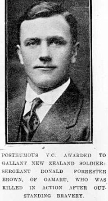 |
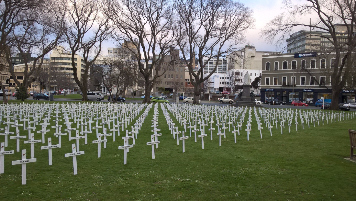 |
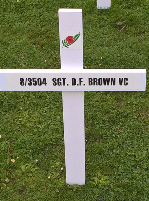 |
VC Citation:
London Gazette 14 June 1917, p.5866
For most conspicuous bravery and determination in attack when the company to which he belonged suffered very heavy casualties in officers and men from machine-gun fire. At great personal risk this NCO advanced with a comrade and succeeded in reaching a point thirty yards of the enemy guns. Four of the gun crew were killed and the gun captured. The advance of the company was continued until it was again held up by machine-gun fire. Again Sgt. Brown and his comrade, with great gallantry rushed the gun and killed the crew. After this second position had been won, the company came under very heavy shell fire, and the utter contempt for danger and coolness under fire of this NCO did much to keep up the spirit of his men. On subsequent occasion in attack, Sgt. Brown showed most conspicuous gallantry. He attacked single-handed a machine-gun which was holding up the attack, killed the gun crew and captured the gun. Later whilst sniping the retreating enemy, this very gallant soldier was killed.
Killed in action France 1 October 1916.
There is a cross honouring Sgt Brown among the 795 crosses making up a Field of Remembrance in Dunedin. The crosses are named for New Zealanders from the Otago Regiment and wider area who died in 1916. The crosses will be in place until Remembrance Day 11th November 2016.
Citation taken from Honours and Awards to the New Zealand Expeditionary Force in the Great War 1914-1918 / Wayne McDonald (3rd edition Published by Richard Stowers)

Commemorations for the 100th Anniversary of The Somme
15th September 2016
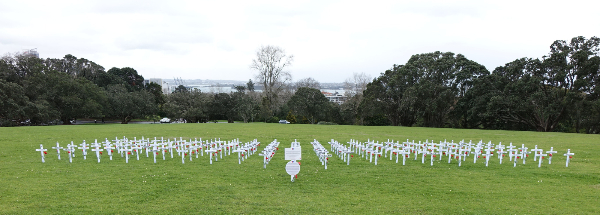 |
 |
 |
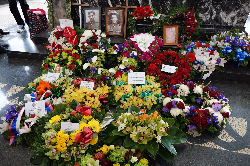 |
 |
A field of 163 crosses bears the names of Aucklanders who died in the battle on the 15th September 1916.
A commemoration ceremony was held in the Hall of Memories, Auckland War Memorial Museum.
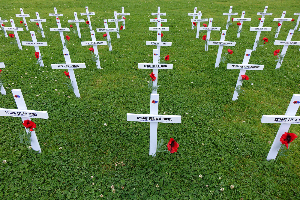 |
 |
WE WILL REMEMBER THEM
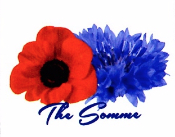
New Zealanders at the Battle of the Somme
15th September 1916
| On 1 July 1916 British and French forces launched an offensive which would become known as the Battle of the Somme. The first day of the battle is regarded as one of the bloodiest days of the First World War with the loss of over 19,000 servicemen of the British Empire. The Somme Offensive lasted for another 141 days. By November winter closed down the battles. The five months of fighting resulted in 420,000 British Empire troops wounded or killed. At 0620 hours on the 15th September 1916 the New Zealand Division fixed bayonets and advanced in four waves toward their objective the village of Flers. 603 New Zealanders were killed that day.
The Division continued fighting on The Somme for another 23 days, advanced 2 miles (3 Kilometres) and captured 1,000 German prisoners of war. By the time they withdrew there were 8,000 New Zealand casualties and over 2,000 dead.The New Zealand Tomb of the Unknown Warrior, National War Memorial,Wellington contains the remains of an unknown New Zealand soldier who died on The Somme. A Field of Remembrance will be laid in the Auckland Domain this month to honour 163 men of the Auckland Battalion and from the wider Auckland region who served and made the ultimate sacrifice on the 15th September 1916. In France the Bleuet de France (cornflower) is the flower of remembrance so our crosses are decorated with a poppy and cornflower motif. We remember all those men who have no known grave with the cross “Known unto God” |
Pre-school students proud to commemorate ANZAC day
-716.JPG)
Ivy-May, aged four, places her poppy in ACG Sunderland Early Childhood Centres memorial garden.
|
As part of the Ministry of Education’s and Fields of Remembrance Trust’s ANZAC activity, ACG Sunderland Early Childhood Centre received a WW1 Commemoration Package, including three small white crosses to honour the men and women who died serving New Zealand during WW1. The young children, aged from 2-5, have been learning about ANZAC in preparation for their annual ANZAC memorial assembly taking place at the school this week. ACG Sunderland Early Childhood Educator Mayling Wang has been teaching the children to make origami poppies. Once the poppies are finished, the children have been respectfully laying their flowers in front of the crosses to form a memorial garden, and have made a wreath of poppies to take with them to the assembly. As well as talking about the significance of ANZAC and learning about the symbols and traditions surrounding the commemorations, the children have been rehearsing the national anthem to sing at the assembly. The children can sing both the Māori and English verses with pride and passion. |
Register your Field
| Across New Zealand Fields of Remembrance are becoming a part of ANZAC Day commemorations. RSAs and community groups are remembering those who lost their lives 100 years ago in the First World War in this very personal and visually dramatic way. |
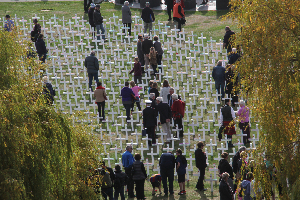 |
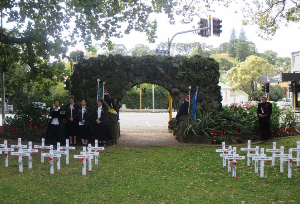 |
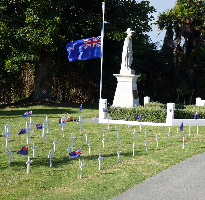 |
| Soundshell, Caroline Bay, Timaru | Epsom Memorial Archway | Matakana Memorial |
| We would love to hear about Fields in your area, your stories and pictures. Please register your field HERE Or contact us HERE |
Auckland Dawn Service
| Concerns have been raised around the role of Veterans in the Dawn Service at Auckland War Memorial Museum. See New Zealand Herald article HERE. |
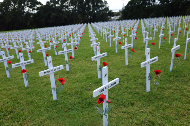 |
This year the Fields of Remembrance Trust established a Field of over 1600 white crosses named for the men and women from the Auckland region who died 100 years ago in 1915 and 1916. |
| The Trust has no part in the planning nor management of the Dawn Service Commemorations. We understand and acknowledge concerns raised and feel it is important that disabled Veterans feel included in commemorations of their service and sacrifice. It is for the disabled veterans themselves to decide whether that be as honoured guests or as active participants. We have passed on those concerns to the organisers. |
We will remember them
| Solemn Civic ceremonies were enacted on this ANZAC Day, with dignitaries, speeches and parades. But there were also a host of small community commemorations where the Fallen of a small town or district were remembered in personal and no-less moving ways. One such was the service at Matakana, a small township north of Auckland. Their memorial lists many names - some from the same family and many with descendants still living nearby. They were remembered. As at ceremonies across the country - children played their part. |
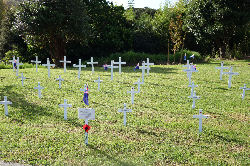 |
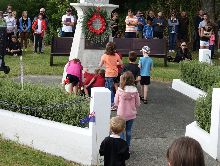 |
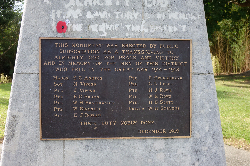 |
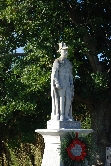 |
| Trust crosses donated to Matakana school have been re-named for the school's own WWI soldiers. | Children lay poppies on Anzac Day 2016. | The Matakana Memorial bearing the names of the Fallen from the area. | The King George statue is 95 years old. |
Fields of Remembrance for Pre-schoolers
 |
 |
| Minister of Education Hon. Hekia Parata with children at the Secret Garden Childcare Centre in Palmerston North. |
| Following the success of the Fields of Remembrance in Schools project in 2015, the Trust in partnership with the Ministry of Education supplied a Remembrance kit to 4,600 early childcare centres. The kits contain three small crosses and the stories of the men and woman named on each. The Minister of Education Hekeia Parata joined children at the Secret Garden Gables Childcare Centre in Palmerston North to commemorate WW1 and assisted with planting poppies. |

Wellington Regional Field 2016
 |
The Salamanca Lawn Field of Remembrance Crosses in the Wellington Botanic Gardens this year contains 1848 crosses named for men from the wider Wellington region who lost their lives in 1915 and 1916. Click HERE for more information |
New Zealand Tunnellers Remembered
| In Waihi a Filed of Remembrance was laid in memory of the New Zealand Tunnelling Company. Recruited in New Zealand in 1915, the men of the Tunnelling Company arrived in France in March 1916 under the command of Major J.E. Duigan. They were the first New Zealanders to reach the Western Front. Most of the tunnellers were quarrymen, gold miners from Waihi and Karangahake, or labourers from the Railways and Public Works departments. Others were coal miners from the West Coast of the South Island, but these workers were generally discouraged from enlisting due to the essential nature of their industry. In November 1916 the Tunnellers moved to Arras where over five months they constructed a complex system of underground galleries, subways, kitchens, headquarters and hospitals – facilities capable of comfortably housing at least 12,000 men at any one time. To assist orientation, the locations in one of the systems were all given New Zealand place names, from Bluff at one extremity to Russell at the other. The New Zealanders also left graffiti on the walls, including a large ‘Kia Ora’ flanked by ferns. |
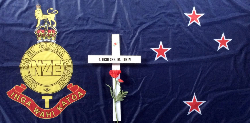 |
One of the crosses in the Field was for Sapper Michael Tobin. He died on 15th April 1916. He was the first New Zealander to die on the Western Front. Learn more about the Tunnellers via their webpage HERE and keep up to date with Facebook HERE |

Defence Force Fields
Fields of Remembrance are being established at Military Bases across the New Zealand.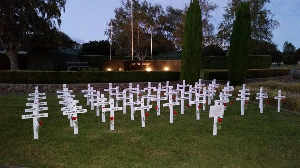 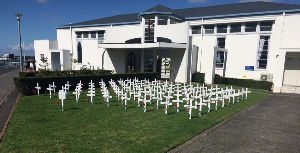 Linton Military Camp and HMNZS Philomel (Devonport) honour the fallen servicemen and women who made the ultimate sacrifice in World War I |
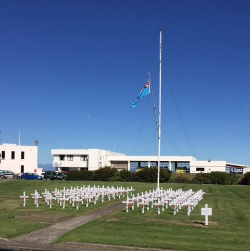 |
 At Trentham - prayers are offered before the crosses are laid in the ground. |
Auckland Field laid
|
The 2016 Auckland Field of Remembrance |
White crosses have again been erected in the Auckland Domain to commemorate those who served and made the ultimate sacrifice. The 2015 Field contained 829 crosses bearing the names of those who died in 1915. We have added 857 for those who died in 1916. They all served with Auckland regiments or came from the wider Auckland region. Throughout the centenary period we will add the names of those who died in the years 1917 and 1918. Click here to view Maori Television's report. Fields will also be erected in the main centres of Wellington, Christchurch and Dunedin. |
New Lapel Pin available at branches of the ANZ Bank
|
|
The first in a series of four lapel pins honouring those who died in significant battles of the First World War is available now from ANZ Bank branches. This cross commemorates the Battle for Chunuk Bair. In August 1915, for a brief time the New Zealanders held the highest point on the Gallipoli - Chunuk Bair. The Chunuk Bair memorial records the names of 852 men who fell in the battle and who have no known grave. |
Fields of Remembrance for pre-schoolers
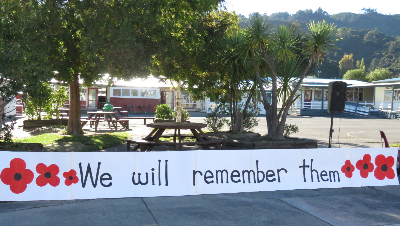 |
The Fields of Remembrance Trust and the Ministry of Education have formed a partnership to support all early learning services in commemorating the sacrifice of our veterans during World War 1 (WW1). Across the country early learning centres (Kindergartens, Playcentres, Kōhanga reo, and Day-care centres) will be sent a WW1 Commemoration Package, including three small white crosses to commemorate the men and women who died serving New Zealand during WW1. The commemoration packages aim to inform and inspire younger generations. For more information read the Early Learning Bulletin here. Activity suggestions may be found here. |
Counting the Cost
There are many graves at Anzac Cove, each one is a pledge, each one a testimony.
|
|
New Zealand 2721 dead, 4752 wounded Australia – 8709 dead, 19,441 wounded Britain 21,255 dead, 52,230 wounded France 9829 dead, 17,175 wounded India 1358 dead, 3421 wounded Newfoundland 49 dead, 93 wounded Total Allies 43,921 dead, 97,112 wounded Turkey 86,692 dead, 164,617 wounded |
One of the other headlines from contemporary newspapers was one that noted:
The majority of Troops went to Sling Camp in England to train for that other theatre of war – the Western Front.

Armistice Day
The 11th hour of the 11th day of the 11th month was the moment when hostilities ceased on the Western Front in 1918, following the signing of an armistice. The Commonwealth War Graves Commission database lists 2843 New Zealand personnel who died between 25 April and 20 December 1915.
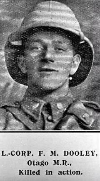 |
|
|
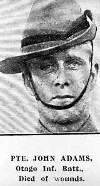 |
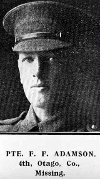 |
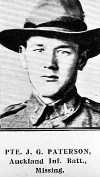 |
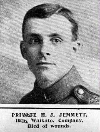 |
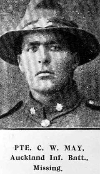 |
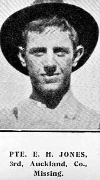 |
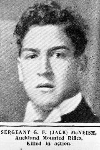 |
 |
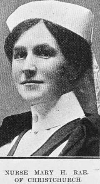 |
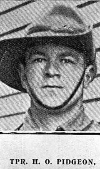 |
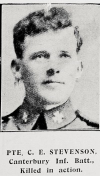 |
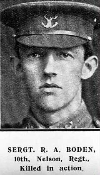 |
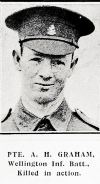 |
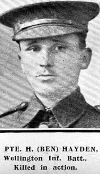 |
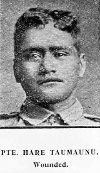 |
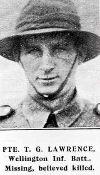 |
 |
WE WILL REMEMBER THEM

Thank you!
The Fields of Remembrance Trust held an event in the Bolton Hotel to acknowledge support for the Trust from supporters and friends.
The Hon Maggie Barry ONZM - Minister for Arts & Culture, Conservation, & Senior Citizens with Fields of Remembrance Trustees - B.J. (Barry) Clark - National President, Royal New Zealand Returned and Services Association; Iain MacKenzie - President Passchendaele Society Incorporated; Graham Gibson - President Auckland Returned and Services Association Incorporated and (at back) Chairman - David McGregor.

Passchendaele Field of Remembrance
| The Passchendaele Society has remembered New Zealand's darkest day with a Field of Remembrance in the Auckland Domain. Five thousand New Zealanders were killed in Flanders during the First World War and there are more New Zealanders buried in Belgian soil than in any other country outside New Zealand. Two thousand four hundred and twelve New Zealanders died in the Passchendaele Offensive from 31 July to 30 November 1917. At the Battle of Passchendaele on 12th October 1917 eight hundred and forty six New Zealanders were killed in action. This symbolic field commemorates all those men. |
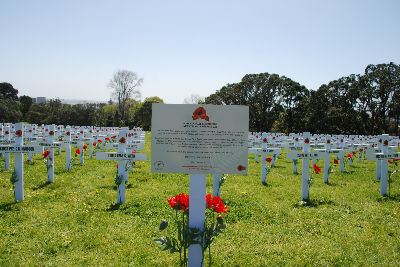 |
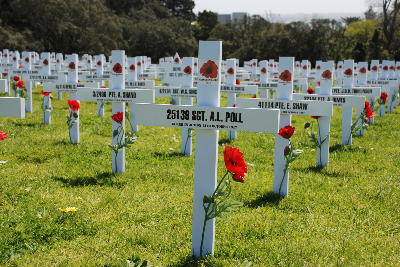 |
The Fields of Remembrance in Schools Project
"Their Stories, Our Stories"
National competition commemorating the centenary of the First World War This entry a garden created by Cam Loft and Cheyenne Ballantine of Hauraki Plains College in Ngatea won the top prize. |
The Ministry of Education and The Fields of Remembrance Trust held a national competition for school students commemorating the centenary of the First World War called “Their Stories, Our Stories”. 148 entries were received in 4 categories (years 1-4, 5-8, 9-10 and 11-13) and students could enter as a group or solo. The judges were impressed with the range and quality of the entries saying that they reflected a huge amount of research, creativity and hard work. The entries included, poems, paintings and drawings, video clips and this prize winning garden. For more information and links to all the entries please click HERE. The competition is sponsored by the RNZRSA, the Auckland RSA, the Vodafone Warriors and Canterbury NZ. |
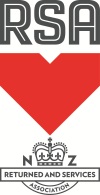 |
 |
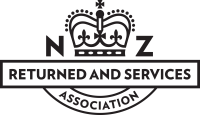 |
 |
Dunedin RSA Field of Remembrance
| 146 young men from the Otago region lost their lives in the Battle for Chunuk Bair in August 1915. The Dunedin RSA honoured their boys with a Field of Remembrance. |
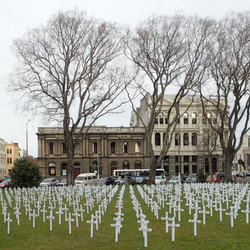 |
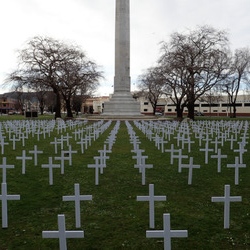 |
 |
Chunuk Bair Centenary, 8 August 2015
The commemorative service to mark the centenary of the Battle for Chunuk Bair will take place on Saturday 8 August 2015, at the New Zealand Memorial and Lower Cemetery at Chunuk Bair on the Gallipoli Peninsula.
779 New Zealanders lost their lives between the 6th and 10th August 1915
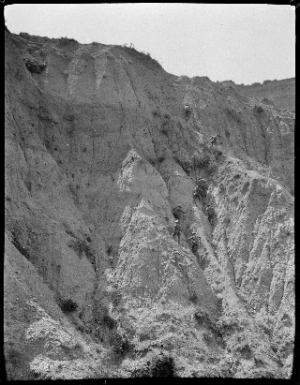 |
Chunuk Bair was one of New Zealand's epic stands on the Gallipoli peninsula. In August 1915 the New Zealanders spearheaded the advance to seize the heights of the Sari Bair Range that dominated the coast above Anzac Cove. The Wellington Battalion under Lieutenant Colonel William Malone captured the summit of the hill Chunuk Bair and for a brief moment the way was open to advance and seize the Straights of the Dardanelles. In two days of fierce fighting the New Zealanders fought off wave after wave of attacks. Despite their efforts, by the morning of 9 August, the battle was lost. Malone was killed on the summit. Corporal Cyril Bassett was awarded the Victoria Cross for his work laying and repairing telephone lines between headquarters and the top of the hill. “All my mates ever got were wooden crosses”
|
For more information on Chunuk Bair go to NZ History.net
For more information on the commemorative service go to Gallipoli 2015
Our Roll of Honour lists the casualties for August 1915
Cook Islands Soldiers of World War One
 |
The Cook Islands Soldiers of World War One (CISWWO) Committee was established to organize events commemorating the contributions of Cook Islands Soldiers that enlisted in World War One (WWI). A Field of 100 white crosses representing the Cook Islands soldiers of World War One were laid out on Parliament lawn in April 2015. The crosses are a symbolic and visual reminder of the true cost of war. |
| The Cook Islands sent 45 men to the war in October 1915. A second contingent of 120 men, with representatives from every island in the group, left Rarotonga for Auckland in July 1916. They went into training at Narrow Neck camp. The second Cook Islands contingent were attached to the NZEF in Egypt but began working for the British in the campaign against the Ottoman Turks in Sinai and Palestine. The group became known as the Rarotongan Company of the NZEF and served in this theatre of war until the end of the war. In December 1918 the Rarotongan Company was returned to New Zealand. Because of the influenza epidemic the men were quarantined on Somes Island in Wellington Harbour. Most of them were sent back to Rarotonga in March 1919, when there was no longer a risk that they would spread infection. |
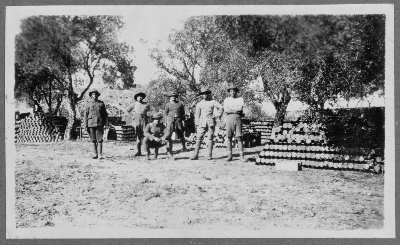 'The Rarotongan Company' http://www.nzhistory.net.nz/war/pacific-islanders-nzef/rarotongans, (Ministry for Culture and Heritage), updated 2-Sep-2014) |

WE WILL REMEMBER THEM“They say you die twice. Once when you stop breathing and the second, sometime in the future, when your name is spoken for the last time.” Banksy after Irvin Yalom
We would love to hear about your Field of Remembrance. Please use the "Register my Field" option to tell us all about how you are remembering the service and sacrifice of your community.
|
Eastbourne Remembers
|
If you would like to receive our Newsletter please sign up at the bottom of the Home page.
| Across Marlborough local communities have been honouring those who fell in service to their country. |
 Seymour Square plot left hand of Cenotaph (In the heart of Blenheim town)
|
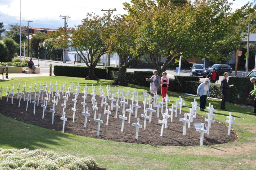 Seymour Square plot right hand of Cenotaph Seymour Square plot right hand of Cenotaph |
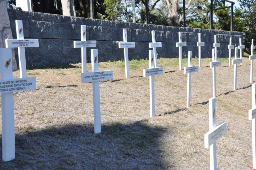 Seddon
|
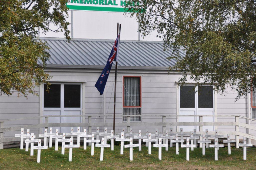 Rai Valley
|
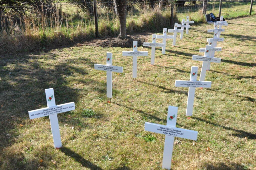 Ward
|

WE WILL REMEMBER THEM
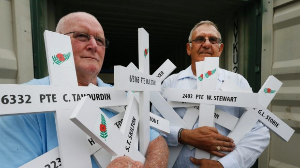 Nelson |
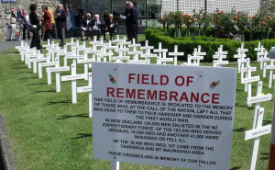 Tauranga |
 Balclutha |
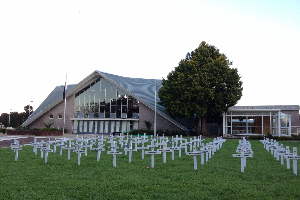 Mt Albert, Auckland
|
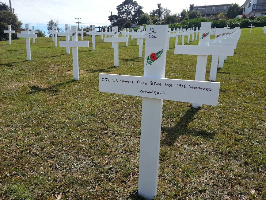 Waiheke Island
|
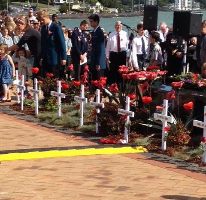 St Heliers, Auckland
|

Fields of remembrance in Schools

| Across New Zealand schools commemorated those who lost their lives in World War I. For images and stories from the schools please click here. |

Auckland Field of Remembrance 1915 - 2015
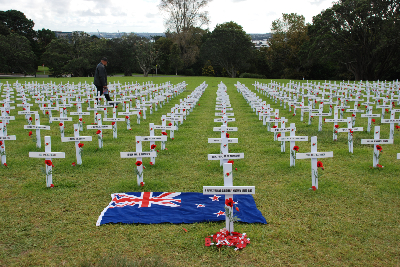
| The Auckland Province Field of Remembrance contains 814 crosses bearing the names of those who died in 1915 |
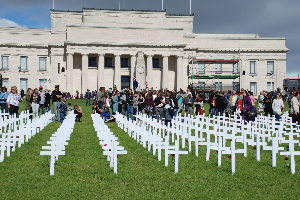 |
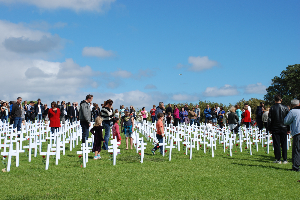 |
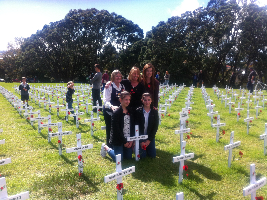 |
|
| Exploring the Field after the 2015 Anzac Commemoration | Reading the names of those who died in 1915 | A Family finds the cross of their soldier |

A cross at Gallipoli
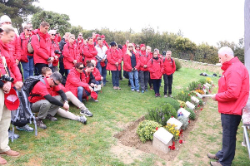 |
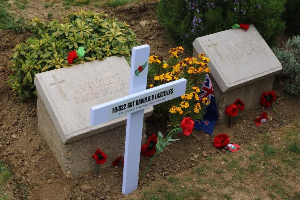 |
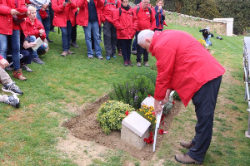 |
|
At the Chunuk Bair Memorial on Gallipoli Phil Lascelles laid a Field of Remembrance cross in memory of his great-uncle
10/822 Sergeant David Robert Breingan LASCELLES
who was Killed in Action on the 8 August 1915 at Chunuk Bair, 9th Hawkes Bay Company, Wellington Infantry Battalion.
Phil travelled to Gallipoli as part of the ANZAC 2015 Volunteers who are supporting the visitors for the ceremonies. |

Matakana War Memorial Field
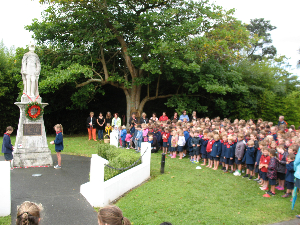 |
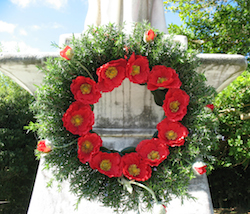 |
 |
| A dedication for the Matakana War Memorial "Field of Remembrance" was performed by the Pupils of Matakana School. The dedication included several readings, the calling out of the Men listed, a performance by the Kapa Haka group and the singing of the National Anthem. In conjunction with the "Field of Remembrance Trust" and a group of Matakana Locals the field was created to represent the men listed on the War Memorial and the ex pupils of Matakana School who fought in the First World War. About 100 people including descendants of the Men listed on the Memorial gathered at the Memorial this morning to witness this dedication and place poppies on the Crosses. |

War Veterans' Field of Remembrance
 |
 |
 |
| The Levin Home for War Veterans has been privileged to care for more than 900 World War I soldiers. This year they have established a Field of Remembrance to honour 300 of these soldiers. “Our field of remembrance commemorates those soldiers who survived World War 1 and chose our home to be their home. We will continue with our project to ensure all 900 soldiers are commemorated.” |

ANZ Bank Field of Remembrance
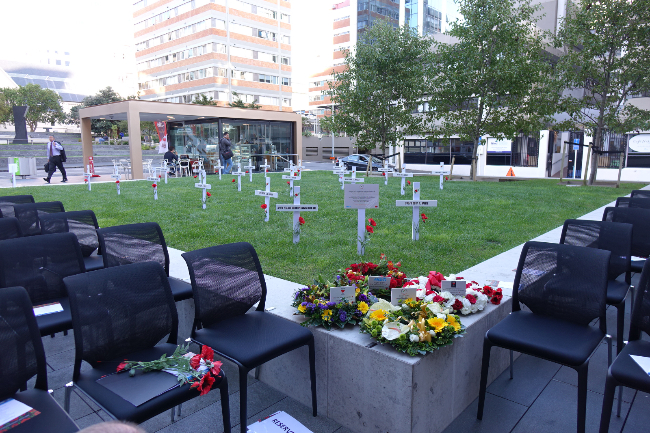
The ANZ Bank has established a Field of Remembrance at its Auckland head office. To commemorate its own staff who were killed in World War I.An early morning ceremony blessed the Field, attended by staff from the ANZ, representatives from the Fields of Remembrance Trust, the RNZRSA, and the defence forces.
A plaque was unveiled “in memory of our colleagues who served and sacrificed”.
The plaque is inscribed:
We are New Zealand’s dead from distant conflict,
our sacrifice remembered ever more.
Rachel Boyd spoke most movingly at the ceremony. Rachel won the ANZ RSA Cyril Bassett VC Speech Competition in 2013 and visited Gallipoli.
Now in its fifth year, the competition was established as a tribute to Cyril Bassett, VC (1892-1983) – the only New Zealander at Gallipoli to be awarded the Victoria Cross, who spent his entire career with ANZ Group.
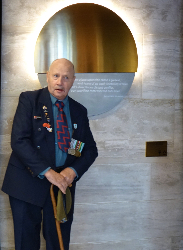 |
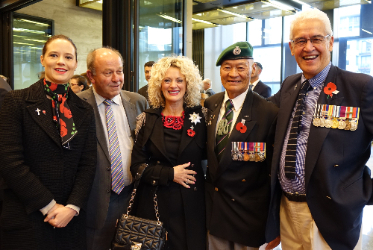 |
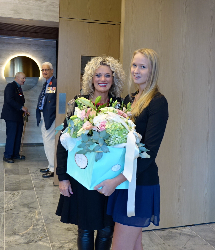 |
| Mike Subritzky and the commemorative plaque. | Dame Trelise Cooper with veterans and staff from ANZ | Rachel Boyd with Field of Remembrance patron Dame Trelise Cooper |
In Flanders fields the poppies blow
Between the crosses, row on row
| Today a Field of Remembrance was established at the Devonport Naval Base and a moving ceremony blessed the Field. The 100 crosses represent the over 18,000 young men and women who made the ultimate sacrifice in World War I. While the crosses symbolize the loss of their lives the poppies, which grew on land shattered by war, symbolize re-birth. Young servicemen and women wandered among the crosses finding the names of SGT. D. GALLAHER the All Black captain killed at Passchendaele, SGT. R.C. TRAVIS VC,DCM,MM,CDG the most decorated of the NZ soldiers winner of the Victoria Cross, young nurse S/NURSE. H.K. ISDELL and LT.COL. W.G. MALONE hero of Chunuk Bair. |
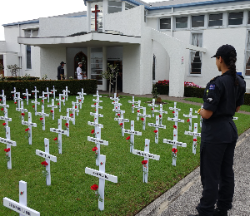 |
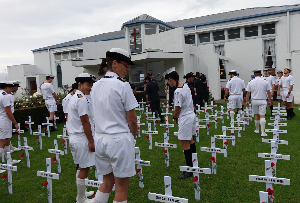 |
 |
| Field alongside the Navy Chapel | Discovering who they were | Poppies and crosses |

Canterbury of New Zealand and Vodafone Warriors Show ANZAC Pride with Commemorative Jersey
“Te Maumaharatanga” (The Memorial)
Speaking at the launch of the jersey Dwaynne Barrie, General Manager for Canterbury of New Zealand, said: “2015 marks the 100 year anniversary of The Battle of Gallipoli and it is with our utmost respect that we acknowledge the sacrifices made by the men and women who have fought, are currently serving and will serve in the future”.
Fields of Remembrance Chairman David McGregor is delighted that Canterbury of New Zealand has put so much care into the design of a jersey that is such a striking acknowledgement of those who have and are currently, serving.
A Field of Remembrance white cross with poppy and fern is featured on the jersey and shorts, and a donation from the sale of each jersey in both New Zealand and Australia will be going to the Fields of Remembrance Trust ($5 for a children’s jersey, $10 for adults), as a mark of respect for our past and current serving armed forces personnel.
Jersey's may be purchased here
 |
Captain Simon Mannering and his Australian back row partner Ryan Hoffman stand on the steps of Auckland War memorial Museum. They are wearing "Te Maumaharatanga", behind them stand representatives of the Army, Navy and Air Force. Find out more about the ANZAC jersey and it's symbolism here. |
||
Regional Fields of White Crosses
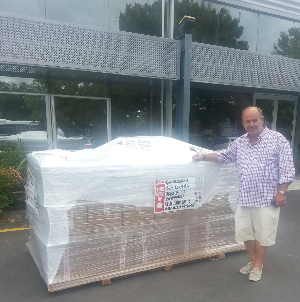 Executive Trustee Graham Gibson with the pallet of crosses bound for Wellington |
The Fields of Remembrance Trust will establish Fields of white crosses in the four main centres on Anzac Day 2015. Each cross will bear the name of soldier or nurse who died in 1915. There will be 811 crosses in Auckland, 866 in Wellington, 632 in Christchurch and 697 in Dunedin. Some servicemen will have a cross in more than one region. They were mourned by family and friends across the country and are remembered on more than one community memorial. The 1915 Fields will also include those who lost their lives in 1914 - either serving with British Forces or through disease. The Auckland Weekly News would publish images of Casualties. |
White Crosses for the New Zealand Defence Force
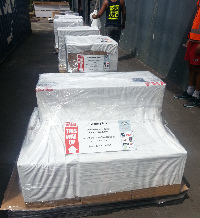 |
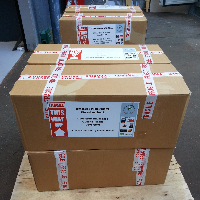 |
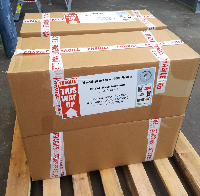 |
| For Linton Military Camp | For HMNZS Philomel | For RNZAF Base |
| This week The Fields of Remembrance Trust has sent out White Crosses kits to enable the nine Military Bases/Camps throughout New Zealand to establish their own field of white crosses commemorating fallen of World War I. Each kit contains 100 white crosses, names and replica Flanders Fields poppies. |
White Crosses for Schools

| Schools around New Zealand will soon be able to create their own Field of Remembrance for Anzac Day. They will be receiving kits of 30 small white crosses, names of soldiers and nurses from their region who lost their life, posters, a booklet and a replica Flanders poppy. The Trust has worked in partnership with the Ministry of Education and with the help of very generous sponsors has produced over 80,000 crosses and 12,500 posters. Find out more about the project HERE |
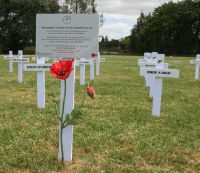 |
First Casualty
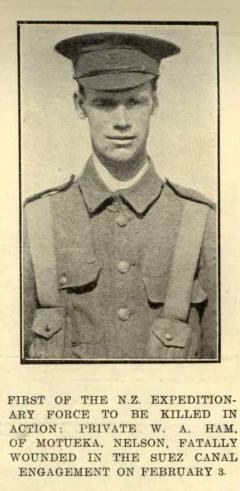 |
On 3 February 1915 the New Zealand Infantry Brigade was engaged in repulsing a Turkish attack on the Suez Canal. The 12th (Nelson) Company was in the midst of the action when Bill Ham was hit by a bullet, which ricocheted off his rifle and hit his neck, breaking his spine. He died of his wounds on the evening of 5 February, becoming the first New Zealander to be killed on active service in the war.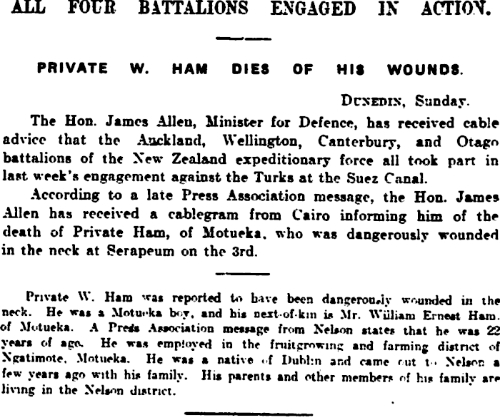 |
Online Cenotaph
| Auckland War Memorial Museum has launched their enhanced Online Cenotaph. This invaluable resource now includes a digital social space where enthusiasts, families, and researchers can share their interconnecting experiences of New Zealand servicemen and women. Find out what's new here. .
|
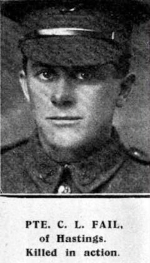 |
The Christmas Truce 1914
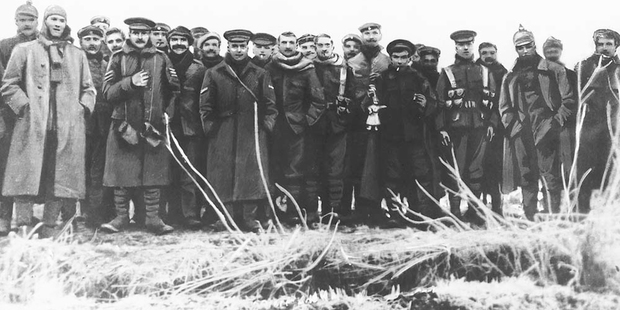 |
|
| In 1914 on Christmas Day the ordinary soldiers on both sides came out of their trenches and got together to share cigarettes, songs and kick a football around. Learn more here: http://www.nzherald.co.nz/world/news/article.cfm?c_id=2&objectid=11378857 http://www.history.com/topics/world-war-i/christmas-truce-of-1914 Sadly their informal truce did not last. |
Swanson RSA Field of Remembrance
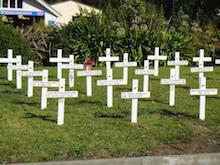 |
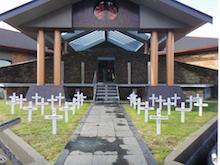 |
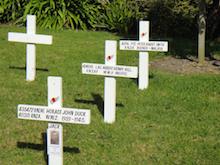 |
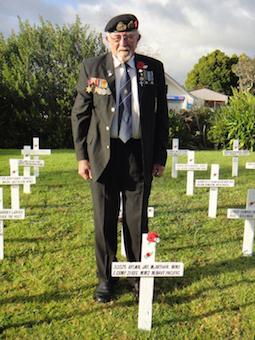 Veteran James (Jim) McArthur has hand-painted all the information on each and every cross. |
For a week at Anzac Day and Armistice Day the Swanson RSA lays a Field of Remembrance. Club members are encouraged to sponsor a white cross in memory of a relative who died in the service of their country. For $10 the cross is personalized with their relative’s details and if they can provide a photo it is laminated and added to the cross. The RSA assists families in researching their relative's details through the CWGC and the Auckland War Memorial Cenotaph Database. The sponsors are free to decorate their crosses as they see fit, fencing staples allow poppies to be attached. Money collected from the crosses goes towards the RSA's Welfare Fund to help with the care of veterans. The club has 28 crosses at the main entrance to the RSA. These crosses represent major battles New Zealand has been involved in since WW1. Wreaths are laid against these crosses on Anzac Day and Armistice Day. Club members have embraced the concept and there are 100 personalised crosses in the Field. |
Remembrance Day
 |
They shall grow not old, as we that are left grow old: Age shall not weary them, nor the years condemn. At the going down of the sun and in the morning, We will remember them. |
| This is the fourth stanza from Laurence Binyon's poem For the Fallen - referred to as the Ode of Remembrance |
Adopt an Anzac Group
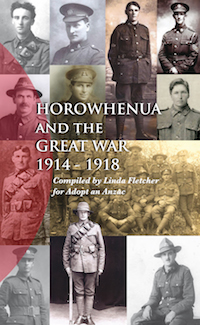
|
A new book remembering the part Horowhenua played in World War 1 is to be launched this month. Horowhenua and the Great War 1914-1918 is the culmination of a research project which began in 2006 to identify all the casualties named on Horowhenua War Memorials. Compiled by Adopt an Anzac member Linda Fletcher it details the lives and deaths of 188 men from the district who died in World War I, telling their stories through letters from the front and obituaries printed in newspapers. Inspired by an Anzac Day speech in Levin’s centenary year by former mayor, the late Sonny Sciascia, Adopt an Anzac set about to identify all the men named on Horowhenua war memorials - Levin, Foxton, Shannon, Tokomaru, Moutoa and Manakau, as well as honours boards in school and halls all around the district. Working from on-line databases, and with information from families, they accumulated biographical details and photographs of the men. “Photographs for our men became very important to us,” Linda said. “Being able to put a face to a name makes a big difference in any situation and it became vital for our researchers, making each man a real person as Sonny had suggested in his speech.” While writing the book the Levin Chronicle from 1910 to 1920 came on line through the National Libraries Papers Past. “It was an amazing source of information about our men,” Linda said. “I found lots of personal details about them through their obituaries and from letters written home by their mates." And there were some great stories. “The brothers from Manakau who died together when stretcher-bearing on the Somme, the Shannon lad who was practising with the regimental band when a shell hit their quarters, and the young soldier who died from a heart attack while rough-housing with his mates on the ship on the way to England and was buried at sea.” The book includes chapters on Horowhenua men who won gallantry awards during World War I and men with connections to the district who were not named on local memorials. An appendix lists the men who served in World War I and returned safely. The book was written and published thanks to two grants from the WW100 Lottery Grants Fund. The foreword has been written by the Governor General Sir Jerry Mateparae. A public launch will be held in Te Takere, Levin, on Wednesday October 22, at 7pm to which the public are invited. Special guest will be Colonel Nick Gillard, Commanding Officer of Linton Camp. |
Fields of Remembrance - Katikati
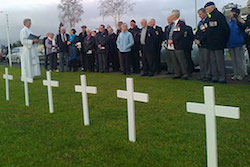 Katikati Field of Remembrance - Photograph from SunLive |
In 1914 the little Bay of Plenty township of Katikati had a population of just four hundred. Sixty of their young men enlisted and went off to war - ten never came home. On August 4th 2014 - the centenary of the declaration of war - a service was held to remember those men. This Field of Remembrance was a real community event, crosses were created by the Katikati Men's Shed with Katikati High School students researching the lives of the young men. Representatives from Katikati RSA, Legion of Frontiersmen Katikati J Troop and Western Bay of Plenty District and the Tauranga City Council all attended the service. |
Poppies of Remembrance
| The red or Flanders poppy was one of the first plants to grow and bloom in the mud and soil of the Flanders battlefields of World War I. Red poppies have become a potent symbol of remembrance the world over. There are several initiatives of remembrance from opposite sides of the world that involve the poppy: |
In Flanders fields the poppies blow Between the crosses, row on row, That mark our place; and in the sky The larks, still bravely singing fly Scarce heard amid the guns below |
| Blood Swept Lands and Seas of Red is an installation of ceramic poppies at the Tower of London. Find out more here. |
We are the Dead. Short days ago We lived, felt dawn, saw sunset glow, Loved and were loved, and now we lie In Flanders fields Take up your quarrel with the foe: To you from failing hands we throw The torch; be yours to hold it high. If ye break faith with us who die We shall not sleep, though poppies grow In Flanders fields John McRae, May 1915 |
Closer to home is 5000 poppies A community Tribute of Respect and Remembrance project in Australia and New Zealand. 5000 hand-crafted poppies are being knitted, felted or sewn to create a stunning visual tribute to New Zealand servicemen and women. They will be displayed at the Air Force Museum in Christchurch from February - July 2015. Find out more here. |
 |
 The Passchendaele Memorial Museum 1917 in Zonnebeke, Belgium is developing seven poppy shaped memorial gardens. It is hoped that New Zealand will be represented with its own garden of Remembrance. Find out more here The Passchendaele Memorial Museum 1917 in Zonnebeke, Belgium is developing seven poppy shaped memorial gardens. It is hoped that New Zealand will be represented with its own garden of Remembrance. Find out more here |
Te Aroha Field of Remembrance
 The Te Aroha Field of Remebrance honours the young men from this small Waikato township who made the ultimate sacrifice in the First World War. The Te Aroha Field of Remebrance honours the young men from this small Waikato township who made the ultimate sacrifice in the First World War. |
 |
Parliament Field of Remembrance
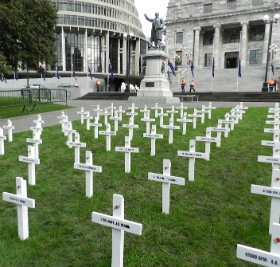 |
The statue of Rt. Hon. Richard SEDDON overlooks a Field of Remembrance in Parliament Grounds. The white crosses, represent the over 18,000 who died in the First World War. During the First World War 1914-1918 five members of the House of Representatives and one from the Legislative Council enlisted. William Henry Dillon BELL MP for Wellington Suburbs and Country Districts was killed in action on the 31st July 1917. A number of Members of Parliament lost their sons and brothers. On one of the crosses is the name of "King Dick's" son Capt. J.S. SEDDON. The Field formed a poignant backdrop for a moving ceremony marking the centennary of the Declaration of War. The last 10 crosses were laid by dignitaries including the Prime Minister and Leader of the Opposition and school children. TV One News item |
.jpg) |
.jpg) |
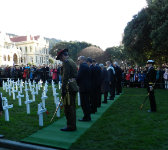 |
.jpg) |
Niue Island and the First World War
 |
“They are a fine lot of men but there are great difficulties encountered in fitting them for active service. They are not accustomed to this kind of life – not accustomed to boots, and not accustomed to military food.” Hon James Allen, Minister of Defence. . |
| It is hard to image a place further from the 1914-1918 conflict than the small, isolated Pacific island of Niue. But in October 1915 150 Niueans arrived in New Zealand and began training at Narrow Neck Significant difficulties faced the men, only one was fluent in English, the climate was cold, the food unfamiliar and with little immunity to common diseases they were very susceptable to illness. In early 1916 they embarked on the SS Navua for a 5 week journey to Egypt where they joined the newly formed Pioneer Battalion. Despite reservations and requests to keep the men in a warmer climate 60 Niueans left Port Said for France. They arrived at Armentieres in May 1916 and began work on the trenches. They worked at night to avoid the worst artillery fire. They had to contend with mud, rats and cold. A mounting casualty rate was of such concern that in late May the decision was made to withdraw the Niuean troops from the Western Front. Over 80% of these men were hospitalised at some point with illness. In England the men gathered at the New Zealand Convalescent Hospital in Hornchurch. On 17th June the first group of 40 men embarked for New Zealand on Corinthic. On 14th July 1916 the remaining 56 men began the homeward journey on Arawa. They were welcomed back to Auckland with a civic and mayoral reception. The New Zealand Herald reported that Hon. Mr James Allen “Welcomed them on behalf of the people of the Dominion and said that he regretted that they had sustained hardships without reaching the firing-line. Their action in offering their services, he said, had won the admiration of the British Empire.” They arrived back in Niue in mid 1917 to much feasting but great sadness too. These are the men who did not return: |
.jpg) |
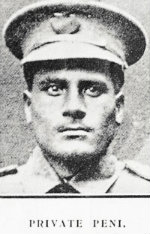 |
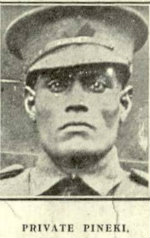 |
 |
| 16/1178 Pte. Vilipate of Liku died of pueumonia 25th December 1915 while training with the N.Z.E.F. at Narrow Neck. He is buried in O’Neill’s Point Cemetary, on Auckland’s North Shore. 16/1062 Pte. Kaimanu of Hikutavake died of measles and pneumonia 15th March 1916 of. He is buried in the Suez War Memorial Cemetery, Egypt. 16/1087 Pte. Mitikele of Hakupu died on of heat stroke (following sentry duty in the fierce midday sun). 16th May 1916. He is buried in Tel El Kebir War Memorial Cemetery, Egypt. Buried in the town of Bailleul, France are: 16/1133 Cpl Tionesini of Hakupu died of pneumonia. 31st May 1916. 16/1155 Pte. Tauetuli of Liku died of pneumonia. 9th June 1916. Buried in the churchyard of St Andrews, Hornchurch are: 16/1177 Pte Vasau of Alofi died of pneumonia.11 June 1916. 16/1132 Pte Taleva of Tamakautoga died of pneumonia.12 June 1916. 16/1046 Pte. Filitoua of Makefu died of pneumonia.19 June 1916. 16/1088 Pte. Moki of Fatiau died of pneumonia. 30 June 1916. Buried at sea of the Corinthic: 16/1115 Pte Peni Meta of Hikutavake died of pneumonia. 23rd June 1916. 16/1179 Sgt Pulu of Hikutavake (brother of Pene) died of pneumonia. 26th June1916. 16/1164 Pte Tiueatama of Lakepa died of septic tonsilitus. 27 June 1916. 16/1179 Pte Vaihola of Avatele died of pneumonia and peritonitis. 28th June 1916 16/1126 Pte Pineki of Alofi died of pneumonia the 4th July Buried in Waikumete Soldiers’ Cemetery, Auckland: 16/1134 Pte Timoko of Hakupu died of tuberculosis. 21 September 1916. 16/1165 Pte Taumataua of Lakepa of tuberculosis. 19 December 1916. Within 5 years of return a further 15 men had died many from pneumonia. But many lived to be old men and they took great pride in their service and sacrifice. Further reading: "Tagi Tote E Loto Haaku My Heart is Crying A Little; Niue Island involvement in the Great War 1914-1918" by Margaret Pointer, Translation by Kalaisi Folau. |
Happenings
   |
Promotional BannersFields of Remembrance have designed and produced a set of five banners to commemorate the First World War for promotional purposes within your community.Click on Merchandise Banners to find out more. |
The Nurses of the First World War
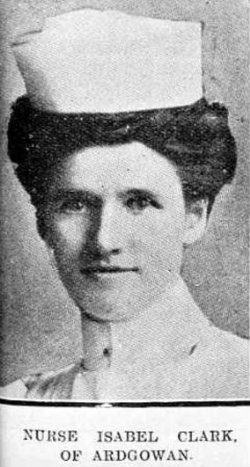 See the Roll of Honour at the New Zealand Army Nursing Service |
550 nurses served with the New Zealand Expeditionary Force. They worked in primitive, often dangerous conditions and 17 of them lost their lives. On 19th October 1915 the Marquette sailed from Alexandria bound for Salonika. On board was the No.1 New Zealand Stationary Hospital which included nurses of the NZ Army Nursing Service and staff from the NZ Medical Corps. Also on board were some 500 officers and troops of the British 29th Divisional Ammunition Column with their equipment and mules. In total there were 741 people on board the Marquette. At 9am on October 23rd 1915 the Marquette was hit by a torpedo from new heavyweight German submarine No.35 and sank within 10 minutes . Many were killed in the explosion and more died from exposure and exhaustion in the cold water. 10 of the 36 nurses aboard died in the disaster, they were :
The nurses who died in the Great War are commemorated in the Christchurch Nurses Memorial Chapel. Further reading - "The other Anzacs : nurses at war 1914-1918" by Peter Rees. |
War Memorials
(copy).jpg) |
Across New Zealand there are War Memorials great and small, grand and personal, in schools and in parks. With their final resting places thousands of kilometers away local memorials were a place for communities to remember their fallen, and a place for families to mourn. .jpg) .jpg) |
Auckland Field of Remembrance
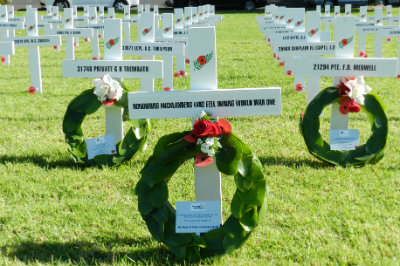 |
To commemorate the over 7,000 Aucklanders who fell during World War One a symbolic Field of Remembrance was established in the Auckland Domain on the 23rd April 2014. Each of the 100 crosses bears the name of a service man or woman who fell. Wreaths were laid by His Worship the Mayor Len Brown; Patron of the Auckland RSA Dame Trelise Cooper and representatives of the Fields of Remembrance Trust; Passchendaele Society; Auckland War Memorial Museum; RNZRSA. |
.jpg) |
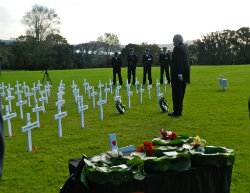 |
.jpg) |
| Mayor Len Brown lays the Cross of Remembrance | David McGregor, Chair Fields of Remembrance | Dame Trelise Cooper, Patron of the Auckland RSA |
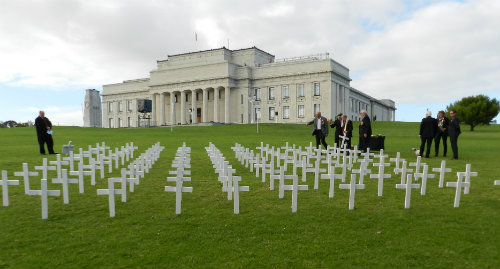
His name be not forgotten
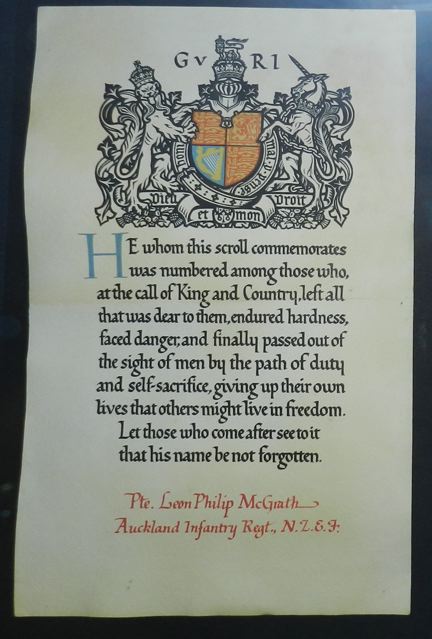 |
This scroll is part of the “Forget-me-Not” display in the Auckland War Memorial Museum. After the war medals and memorial plaques were sent to next of kin. The relatives of these four men whose items are on display could not be traced. Killed in Action: Leon Philip McGrath 8 May 1915 Daisy Patch, Gallipoli Albert James Newton 27 Sept 1916 Somme, France William John Burgess 7 June 1917 Messines, Belgium William Lightfoot Vine 23 June 1917 Messines, Belgium .jpg) The majority of the soldiers who died in the First World War were single men and left no direct descendants. The Fields of Remembrance offers an opportunity for “those who come after to see to it that his name be not forgotten.” |
New Zealand War Stories
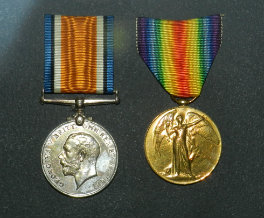 |
Television series. Sir Tony Robinson (Time Team, Time Walks, Blackadder) is filming a new series called Tour of Duty. This series focuses on the lives of the people who went to war and those who stayed at home in the past 100 years since the beginning of World War I. |
Established and Planned Fields of Remembrance
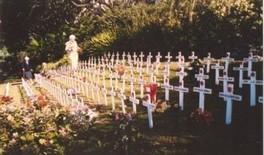 |
Good news. The Fields of Remembrance Trust White Crosses project is gaining significant traction within a wide range of communities. |
|
Planned and committed |
Other Outcomes AchievedOther significant outcomes that have been achieved during the last two months are:Completed the following sections of the website:
Received 2,500 carded lapel pins which are available for purchase, and also received 2,500 loose lapel pins and 200 presentation box lapel pins for promotional activities. Finalised the design and ordered 25,000 red poppy and green fernleaf self-adhesive decals for adhering to the White Cross uprights with delivery expected about 28 March 2014. |
Their name liveth forevermore
|
|
The Commonwealth War Graves Commission commemorates the million men from British Empire who died in the First World War. They are commemorated in graves and on memorials across Turkey and the Middle East. There are almost a 1,000 cemeteries along the line of the Western Front in Belgium and France. Those ordered cemeteries are places of serene beauty and terrible sadness. They came into being thanks to the vision and determination of one man – Sir Fabian Ware. In the chaos of war the dead were often buried where they fell, with little to identify the soldier. As early as 1915 Ware, commander of a mobile ambulance unit began recording the final resting places of the dead. In May 1917 the Commonwealth War Graves Commission was established by Royal Charter. |
After the war the Commission began the work of designing and constructing the cemeteries and memorials. Three of the most eminent architects of the day - Sir Edwin Lutyens, Sir Herbert Baker and Sir Reginald Blomfield were involved. Rudyard Kipling advised on inscriptions. |
.jpg) |
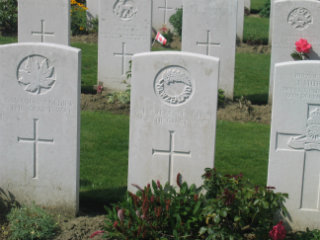 |
Sir Fabian Ware believed in the principle of equality of treatment for the fallen – that their ultimate sacrifice should be commemorated whether the soldier was an officer and a gentleman or a private soldier, whether Anglican or Catholic, Jewish , Muslim or Hindu. It was not without considerable opposition from those who wanted to bring bodies home for private burial; those who wanted to raise their own headstones and monuments and those who wanted overt Christian symbolism. |
"He is not missing, he is here." Field Marshal Lord Plumer at the unveiling of the Menin Gate Memorial, July 1927 A further 559,000 casualties were registered as having no known grave and so the great memorials to the missing were raised. The Menin Gate in Ypres lists 54,986 names and Thiepval Memorial in France with a further 70,000 names. |
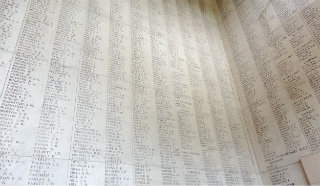 |
 Memorial 1(copy).jpg) |
New Zealander’s are not recorded on either of these memorials but rather are remembered as near where they fell as possible – Messines Ridge, and Tyne Cot (Passchendaele) , Chunuk Bair (Gallipoli). The commission continues it works and commemorates the 1,700,000 men and women of the Commonwealth forces who died in the two world wars. "Our cemeteries, burial plots and memorials are a lasting tribute to those who died in some 153 countries across the world.” CWGC |
Visit - Commonwealth War Graves Commission Website, where you can search their database to find a service man or woman’s last resting place or memorial.
January 2014
|
|
Nancy Simcox (nee King) 43268Nancy Simcox on her 100th birthday at Otaki RSA. Nan is the second oldest living veteran of the Nursing Corps. At her party Don McIver (President RNZRSA and Fields of Remembrance Trustee) presented her with a Fields of Remembrance Badge which she was very proud to receive and wear. Nancy was registered as a nurse in 1938, she joined the Nursing Corps in 1941 and served in Fiji, New Caledonia, Guadalcanal, Middle East, and Italy. |
November 2013
Devonport Field of Remembrance
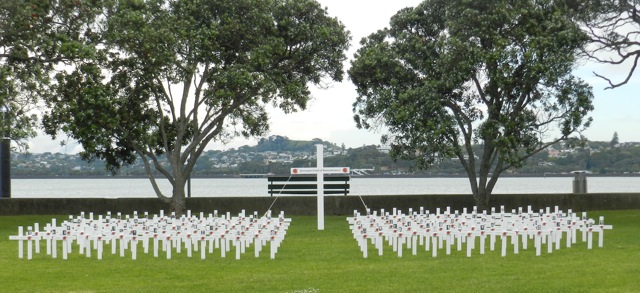
This Field of Remembrance was established by the Devonport-Takapuna Local Board and the Devonport RSA to commemorate those of Devonport’s sons who died in World War One. It is intended as a focal point for the Devonport community to show their respect for the sacrifice of those young lives one hundred years ago.
The Field will be established for every Anzac Day, Remembrance Day and other commemorative occasions and remain for some days while the community reflects on the price of freedom.
In time, it is anticipated the Field will grow to include those lost in other conflicts. Additionally, current Devonport residents may wish to include their acknowledgment of someone dear to them, who may not have come from Devonport, but who gave their life in service to their country.
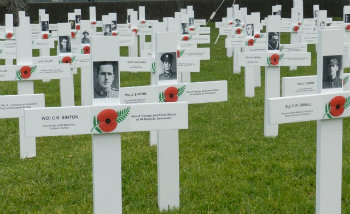
Yours is a pilgrimage of those who passed this way. You will tread reverently, for it is holy ground. It is the shrine of those who won the right for us all to have a country of our own.
Captain Reverend Edward Noel Mellish VC, MC - 1920
October 2013
The Passchendaele Society commemorated the 96th Anniversary of the Battle of Passchendaele in a moving ceremony held in the First World War Hall of Memories, Auckland War Memorial Museum. The Battle of Passchendaele was fought in Belgium on the 12th October 1917. By the end of the day the total number of casualties, the wounded, the missing and the dead was 2,700. 846 young New Zealanders were confirmed dead making this New Zealand's darkest day.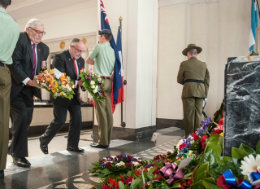
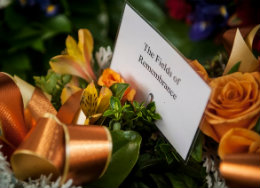
David MacGregor, Fields of Remembrance Trust Chairman and Chris Mullane, Vice-President Passchendaele Society lay wreaths at the Battle of Passchendaele Commemoration 96th Anniversary on 12th October 2013.
 Login
Login

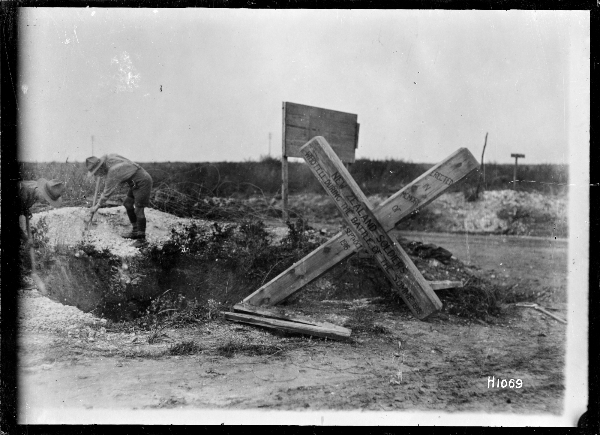

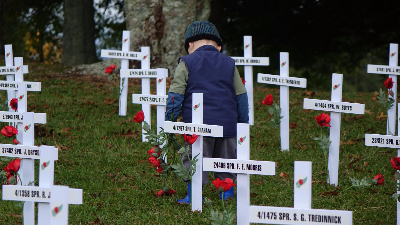
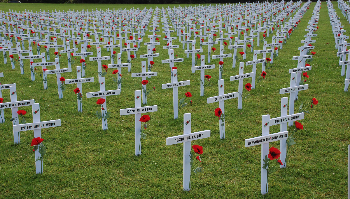
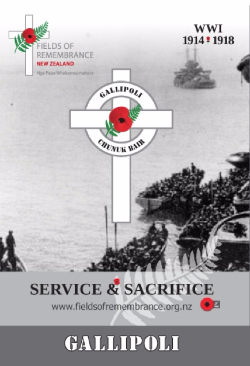
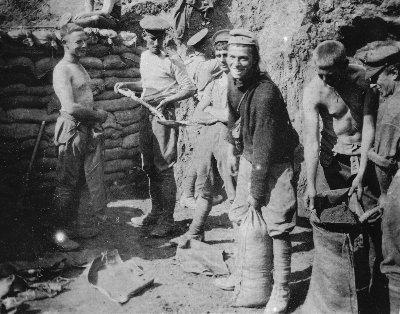
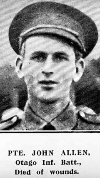
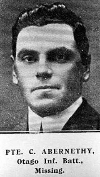

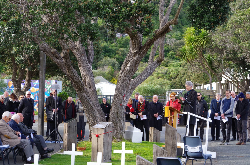
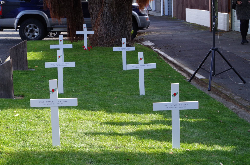

-2-735.jpg)
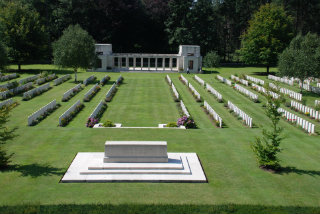
.jpg)